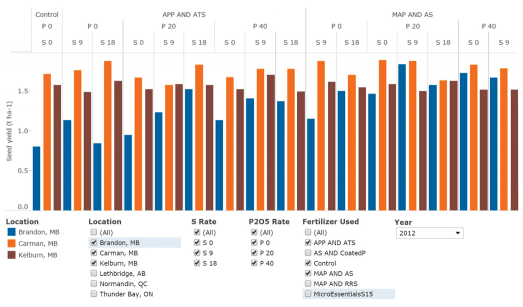Impacts of fertilizer on yield
Profitable canola production relies heavily on the management of soil fertility. Balanced, effective fertilizer management not only contributes to profitable canola yield but also helps to maintain the productivity of the
soil resource.
“Improving Nutritent Management in Canola and Canola-Based Cropping Systems” was a broad study to evaluate improved practices for sulphur (S), phosphate (P) and nitrogen (N) management in canola, led by Cynthia Grant with Agriculture and Agri-Food Canada (AAFC), Brandon.
The objectives of this study were to determine: (1) safe rates of P and S blends that can be seed-placed across a range of environments; (2) the effect of traditional and enhanced-efficiency P and S fertilizers on seedling damage, nutrient-use efficiency, crop yield and canola quality; (3) how preceding crops influence soil quality, microbial activity, canola yield, crop quality and the rate of fertilizers needed for optimum yield and quality; and (4) how various novel S fertilizer sources influence canola yield and quality for biodiesel production.
Sulphur and phosphorus
For the first two objectives, the Grant study evaluated various combinations of seed-placed P and S fertilizer, using different forms and rates.
About half the site years showed seedling toxicity with excess rates of monoammonium phosphate plus ammonium sulphate (MAP + AS) or ammonium polyphosphate plus ammonium thiosulphate (APP + ATS) in combination. Seed-placed P and S significantly reduced stand density at several of the sites, with the effect of S being particularly damaging.
Microessentials-15 (MES15) or the rapid release sulphur (RRS) product occasionally reduced seedling damage but did not generally increase final seed yield as compared to the traditional MAP + AS.


Seed yield increased with the application of P and S at two-thirds of the sites, with highest yield occurring when both nutrients were applied. Yield response to P and S varied considerably from site to site and was generally not strongly affected by the source of fertilizer. In contrast, where the yield response to S was strong, yield tended to be greater with the AS sources than with the other, possibly more slowly available forms. (See Table 1.)
Influence of preceding crops
To evaluate the influence of preceding crops, the Grant study seeded flax, canola and wheat in the first year of a two-year cropping sequence. Researchers applied recommended rates of N, S and P for the location and crop, based on soil test values. The following year, canola was grown using a standard rate of 20 kg P2O5/ha as seed-placed MAP, with varying rates and sources of N and S fertilizer.
Canola yield tended to be the highest after wheat and the lowest after canola. Highest yields generally occurred when both N and S were applied at moderate to high levels. (See Table 2.)
John O’Donovan with AAFC Lacombe led another recent study focused on the effect of preceding crops on soil fertility and resulting canola yield. “Legume Crops to Improve Soil Fertility for Enhanced Canola Production” investigated the effects of growing canola on various legume crop residues compared to wheat and canola residues. The objective was to determine if this practice would provide an economical supplement to the nitrogen requirements of canola and potentially reduce the amount of inorganic nitrogen required to optimize yield.

Significant increases in canola yield occurred on pea and lentil residue at many test sites, but the increases were generally not as high as when canola was grown on fababean green manure. (See Table 3.)
O’Donovan concluded that growing legume crops in rotation with canola can provide a viable alternative to inorganic nitrogen. Legumes can provide a nitrogen benefit to the following crop, but a consistent, measurable benefit does not extend to crops grown two to three years afterward.
More detail on the findings of these two studies, and an expanding library of many more, can be found at the Canola Research Hub online at canolaresearch.ca.




